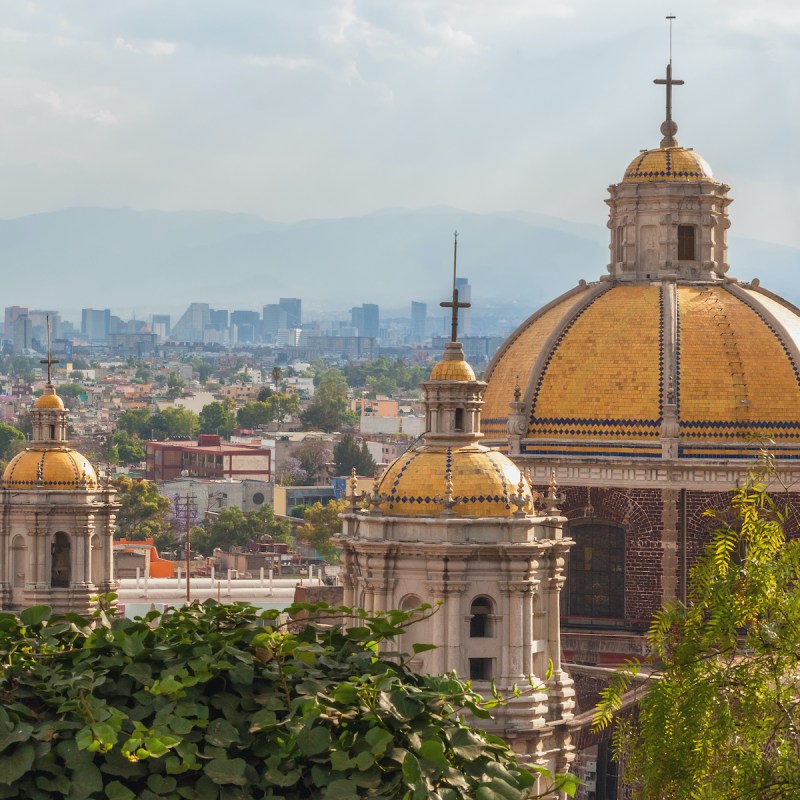
After visiting Mexico for more than 25 years, my husband and I enjoyed the country so much that in 2005, we bought a home in the UNESCO World Heritage City of Guanajuato, Mexico, where we now live part-time. Ever since, whenever we’re in Mexico we make a point of visiting new areas within this rich, diverse country — but we always avoided Mexico City, whose size and complexity intimidated us.
Videos by TravelAwaits
Finally, 8 years ago, we ventured into “CDMX” (short for Ciudad de Mexico), and now we can’t get enough of this iconic city, discovering new delights each time we visit.
Others agree. On a Quora thread I read recently, everyone agreed Mexico City is one of the most underrated cities in the world. One person wrote, “I’ve never experienced anything like the energy of this city. Free music, performance art, paintings and murals, amazing architecture, wonderful food.”
Built upon an ancient lake bed and the site of Tenochtitlán, the ancient capital of the Aztec empire, Mexico City is filled with history, culture, archaeology, architecture, museums, entertainment, and colonias, or neighborhoods — about 350, each with a unique flavor and style.
Here are my favorite areas in Mexico City, and a couple on my list:

1. The Colonias Of La Condesa And Roma Norte
Mexico City is a great city for rambling, and Barry and I usually stay in the colonias of La Condesa or Roma Norte because we enjoy walking. These hip neighborhoods boast wide sidewalks, leafy trees, Art Deco mansions, and small plazas with benches and fountains. They are punctuated with boutiques, art galleries, restaurants, and bars.
I love strolling down the landscaped pedestrian path in the center of Avenida Amsterdam. When I wander around nearby Parque España, a park in La Condesa built in the 1920s, I sometimes wonder, “Am in Paris?”
Within Parque España is the audiorama, a place to enjoy relaxing music or sounds. In this park-within-a-park, hidden behind a bamboo wall, you can read under the tree canopies, listening to piped-in classical music. An inviting trunk filled with books is situated at the entrance.
Another, older audiorama is located within Mexico City’s largest park, 1,700-acre Chapultepec Park. While the park itself is world-famous and gets up to 40,000 visitors a day, the audiorama, surrounded by trees and rocks, feels like a secret garden where you can sit, read, journal, or daydream on one of its colorful benches.
2. Coyoacán
This colonia feels more like a Mexican village than part of a mega-city.
The neighborhood is filled with old churches, cobbled lanes, and small plazas with restaurants, coffee shops, lots of bookstores, and two markets to browse. The area is famous for its historic museums, including Casa Azul, where the Mexican artist Frida Kahlo was born and died, and the home of many of her personal belongings and artworks. To visit the museum, reserve your tickets online in advance. And bear in mind that museums in Mexico are usually closed on Mondays.
Only a few blocks away is the Leon Trotsky House Museum, where the Russian revolutionary lived with his wife, Natalia Sedova, while exiled from Stalinist Soviet Union. He was befriended by Diego Rivera and Frida Kahlo. In 1940, Trotsky was assassinated by a Spanish Soviet agent who struck him with an ice axe.

3. Plaza Santo Domingo
This often overlooked small colonial plaza next to the Baroque church of the same name is a few blocks north of Mexico City’s Zócalo, or principal plaza. Whereas the Zócalo is vast, Plaza Santo Domingo, surrounded by lesser-known museums, churches, and historic sites, has a sense of intimacy and human scale.
The square was once filled with professional scribes who used ancient manual typewriters to type up legal and financial documents for illiterate or indigent clients. The old men are still there, with their gaggle of printers, presses, and electric typewriters. We sat on a bench on the plaza, gazing at the old church and soaking in the sense of being in a quieter era.
4. Palacio De Bella Artes (Palace Of Fine Arts)
This opulent marble Art Nouveau building, dedicated to the fine arts, houses the city’s top performance hall and an art museum.
The museum is known for its twice-weekly Ballet Folklórico de México concerts and for the murals of the Mexican artists Diego Rivera, José Clemente Orozco, David Alfaro Siqueiros, and Rufino Tamayo, the leaders of the Mexican mural movement in the 1920s. Admission is free on Sundays.

5. Cerro De La Estrella
You’ve probably heard of the UNESCO World Heritage Site Teotihuacan pyramids not far from Mexico City, but you may not realize that within the city itself exist several other pyramids, including in Cerro de la Estrella National Park, one of Mexico City’s oldest archaeological sites, dating to about 1,000 BCE.
From the museum at the bottom, it’s a 15- to 20-minute walk among eucalyptus, pine, and cedar trees to the temple at the top, which the ancients called the “Sacred Mountain.” After enjoying the incredible views, you can hunt for petroglyphs, explore some of the 100 caves, visit the new cactus and agave garden, and see the recently restored gardens of flowers to attract bees.
6. The Basilica Of Our Lady Of Guadalupe
The Basilica Of Our Lady Of Guadalupe, one of the most important pilgrimage sites of Catholicism, is a national shrine built near the hill of Tepeyac, once an Aztec worship site.
The faithful believe that in 1531, Juan Diego, a poor indígena (Native Mexican) saw a vision of the Virgin Mary, who told him she wanted a church built in her honor on the hill. Juan reported the vision to his bishop, who asked for a sign. When he returned to the spot where he’d seen Mary, she reappeared and told him to pick some roses and take them to the bishop. After opening his tilma (cloak), the flowers fell out and an image of a dark-skinned Mary was miraculously imprinted on the fabric. The story of Juan Diego became a sign that God didn’t just belong to white Europeans, and that he loved the Native peoples of the New World.
Juan Diego’s tilda, imprinted with the image of Mary, is housed in a gilded frame within a circular basilica. You can view it from a slowly moving sidewalk below. Barry and I are not traditional believers, but we found the visit profoundly moving nonetheless.

7. The Mexico City Metro
Still On My List
The metro is not just a practical means of transit — it’s an end in itself, sheltering many curiosities beneath the surface of the city.
For instance, you can explore the seemingly endless bookshops that line the long corridor between the Pino Suarez and Zócalo metro stations; visit the 650-year-old tiny pyramid at the Pino Suarez metro stop, discovered by construction workers in 1967; check out the simulated night sky, complete with constellations and planets, at the La Raza metro station; and stand on a balcony or a staircase at the Tacubaya metro station to peer at the colorful murals depicting Aztec gods and ancient cities.
Of the above underground sights, I’ve only seen the night sky at the La Raza metro station, so the rest are on my bucket list.
8. El Desierto De Los Leones National Park
Still On My List
El Desierto de Los Leones National Park, a large national park located southwest of the city, is also on my list to explore the next time we visit. Despite its name, the park is not a desert and in fact has several waterfalls throughout the forest of pines, firs, and oaks. It also has panoramic views of the surrounding mountains, extensive hiking and biking trails, as well as beautiful gardens within the ruins of an abandoned 7th-century Carmelite convent.
From architecture to art, plazas to parks, and the secular to the spiritual, Mexico City is a feast for the senses and the mind. Don’t let its size put you off. It’s a city made up of easily digestible neighborhoods, dotted with rincones (nooks or niches). I recommend you do what we do — absorb all the sensory stimulation it has to offer, then stop and take breaks whenever you need to. Visit this city in bite-sized pieces and enjoy its many eclectic pleasures at a leisurely pace.
Getting Around
Not only does the city offer an abundance of wonders to explore, it’s easy to navigate, with its fast, frequent, and unbelievably cheap metro system costing only 25 cents a ride. Many tourists feel safer using Uber, but when our destination is too far to walk, Barry and I prefer to avoid the heavy traffic on city streets and hop on the metro. In our opinion, it’s the easiest and fastest way to get around Mexico City.
We take precautions, of course, keeping our pockets empty and our bags in front of us, and avoiding peak hours, when the trains are packed. If a train is too crowded, we wait for the next one, which almost always arrives within a few minutes. Mexico City’s metro has by far the most frequent trains I’ve ever experienced.
If you’re female, another way to protect yourself is to use the separate carriage dedicated for women and children only, located at the end of most trains. Look for the markings indicating where these cars will arrive.
For more from Louisa on Mexico, check out:

